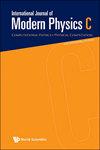Cascading Failures in Interdependent Networks with Reinforced Crucial Nodes and Dependency Groups
IF 1.6
4区 物理与天体物理
Q3 COMPUTER SCIENCE, INTERDISCIPLINARY APPLICATIONS
引用次数: 0
Abstract
Previous studies of group percolation models in interdependent networks with reinforced nodes have rarely addressed the effects of the degree of reinforced nodes and the heterogeneity of group size distribution. In this paper, a cascading failure model in interdependent networks with reinforced crucial nodes and dependency groups is investigated numerically and analytically. For each group, we assume that if all the nodes in a group fail on one network, a node on another network that depends on that group will fail. We find that rich percolation transitions can be classified into three types: discontinuous, continuous, and hybrid phase transitions, which depend on the density of reinforced crucial nodes, the group size, and the heterogeneity of group size distribution. Importantly, our proposed crucial reinforced method has higher reinforcement efficiency than the random reinforced method. More significantly, we develop a general theoretical framework to calculate the percolation transition points and the shift point of percolation types. Simulation results show that the robustness of interdependent networks can be improved by increasing the density of reinforced crucial nodes, the group size, and the heterogeneity of group size distribution. Our theoretical results can well agree with numerical simulations. These findings might develop a new perspective for designing more resilient interdependent infrastructure networks.具有增强关键节点和依赖组的相互依赖网络中的级联故障
以往关于具有增强节点的相互依赖网络中群体渗流模型的研究很少考虑节点增强程度和群体大小分布异质性的影响。本文对具有增强关键节点和依赖组的相互依赖网络中的级联失效模型进行了数值分析研究。对于每一组,我们假设如果一组中的所有节点在一个网络上出现故障,则依赖于该组的另一个网络上的节点将出现故障。研究发现,富渗相变可分为不连续、连续和混合相变三种类型,这取决于增强关键节点的密度、群大小和群大小分布的非均质性。重要的是,我们提出的关键加固方法比随机加固方法具有更高的加固效率。更重要的是,我们建立了一个计算渗流过渡点和渗流类型转移点的一般理论框架。仿真结果表明,通过增加增强关键节点的密度、群体大小和群体大小分布的异质性,可以提高相互依赖网络的鲁棒性。我们的理论结果与数值模拟结果吻合得很好。这些发现可能为设计更具弹性的相互依赖的基础设施网络提供新的视角。
本文章由计算机程序翻译,如有差异,请以英文原文为准。
求助全文
约1分钟内获得全文
求助全文
来源期刊

International Journal of Modern Physics C
物理-计算机:跨学科应用
CiteScore
3.00
自引率
15.80%
发文量
158
审稿时长
4 months
期刊介绍:
International Journal of Modern Physics C (IJMPC) is a journal dedicated to Computational Physics and aims at publishing both review and research articles on the use of computers to advance knowledge in physical sciences and the use of physical analogies in computation. Topics covered include: algorithms; computational biophysics; computational fluid dynamics; statistical physics; complex systems; computer and information science; condensed matter physics, materials science; socio- and econophysics; data analysis and computation in experimental physics; environmental physics; traffic modelling; physical computation including neural nets, cellular automata and genetic algorithms.
 求助内容:
求助内容: 应助结果提醒方式:
应助结果提醒方式:


